 •
H O M E • W
R I T E R 'S N I B S • L
I N K S • B
L O G •
C O N T A C T •
•
H O M E • W
R I T E R 'S N I B S • L
I N K S • B
L O G •
C O N T A C T •
• S
C R I B B L I N G S •
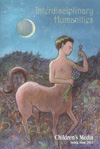
INTERDISCIPLINARY
HUMANITIES
Classroom Comics
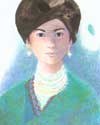
GODDESSES
IN WORLD CULTURE
The Maiden with a
Thousand Slippers
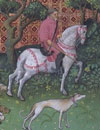
PRIMITIVE ARCHER MAGAZINE
Hunting Through
Medieval Literature

INTERDISCIPLINARY
HUMANITIES
Peter
Pan

HORSE
& RIDER MAGAZINE
A Whisper and a Prayer

COURSE CURRICULUM
ARTICLE
Christine de Pizan
"If
you steal from one author, it's plagiarism; if you steal from many, it's
research."
Wilson Mizner, 1876-1933, American Author
(Please use appropriate citations)
HOSTAGES
IN THE ROSE GARDEN:
Feminine Neurosis in Jean Cocteau's
La Belle et La Bête
by Doré Ripley, ©2007-23
WHAT
DOES Beauty and the Beast say to young women? Bruno Bettelheim
suggests Beauty's love of the Beast is a "magic mirror" reflecting
feminine "evolution from immaturity to maturity" (Enchantment
304), while Jack Zipes believes the story passes on social customs and
manners (Origins 124). Jean Cocteau's 1947 film, La Belle et
la Bête, presents dark images of male/female relations with
a beast who is seductive instead of awful (Diary 2), a beast whose
powerful gaze objectifies Beauty. A voyeuristic fable for mature audiences
that displays the story-book roles society expects men and women to fulfill
(Darker-Smith 2). In five minutes of the film, Beauty goes from fainting
at the sight of the Beast to a submissive, "You are the master here,"
until finally declaring, "There are far more monstrous than you,
though they conceal it well." Beauty and the Beast presents
women as homebound hostages, who eventually exhibit neurosis by manifesting
the psychological behaviors attributed to the Stockholm syndrome.
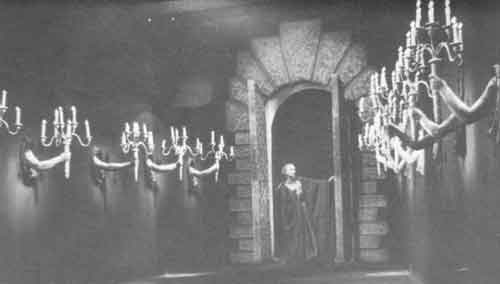
The
familiar version of Beauty and the Beast came from the pens of
Madames d'Aulnoy and Villeneuve and was meant for "the entertainment
of court" friends and other intellectuals of the French salon (Hearne
2). The ladies of pre-revolutionary France used literary fables to "comment
on love, courtship, and marriage . . . [and were] taken very seriously
by the writers and their audience" (Zipes When 43). European
women were influenced by "romantic fiction [and] gradually gained
. . . the right, first, to refuse to cooperate in arranged marriages,
and eventually, to choose husbands for themselves" (Ross 55). Unfortunately,
by the 1750s, the literary fairy tale emphasized the "enforcement
of a patriarchal code of civilité to the detriment of women"
(Zipes Origins 124), and by the last quarter of the eighteenth-century,
fairy tales were the sole property of pedagogues.
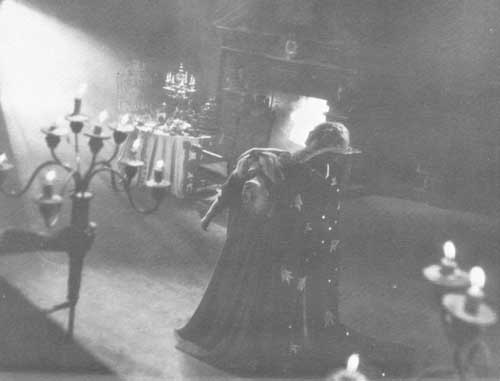
Beauty
and the Beast begins with the loss of a fortune. Beauty's father leaves
home to recover his wealth, promising to bring his daughter the single
rose she asks for. When he runs across an abandoned palace, he plucks
a rose from its garden, causing the castle's beastly owner to demand the
merchant's life in exchange. But, says the Beast, the merchant may substitute
one of his daughters, if she comes willingly. Against her father's wishes,
Beauty complies with the Beast's demand, agreeing to remain at his castle.
Beauty's "self-sacrifice" (Zipes When 47) is met with
"self-determination" (Hearne 15) to honor her word. Her ultimate
attraction to the Beast, while the product of his good and kind inner
nature, reflects hostage neurosis. A neurosis which manifests when captives
harbor "positive feelings . . . toward the hostage taker" (Fuselier
22).

The
Stockholm syndrome gained its name from a botched 1973 Swedish bank robbery,
where an escaped convict and his former cellmate held four bank employees
captive in a vault for 131 hours (Fuselier 22, Graham 1). Dr. Dwayne Fuselier,
a psychologist with the Federal Bureau of Investigation outlines its manifestation.
The hostage may feel anger or frustration towards the authorities. The
captive may show sympathy or other positive emotional feelings towards
the hostage taker (24), especially if the hostage taker reciprocates those
positive feelings (25). In the Swiss bank robbery, one of the captives
engaged in a consensual sexual affair with her captor, and refused to
testify against him at trial (Giebels 243). "Since then, the term
'Stockholm syndrome' has become synonymous to the strong emotional bond
that may develop between hostages and hostage-takers" (Giebels 243).
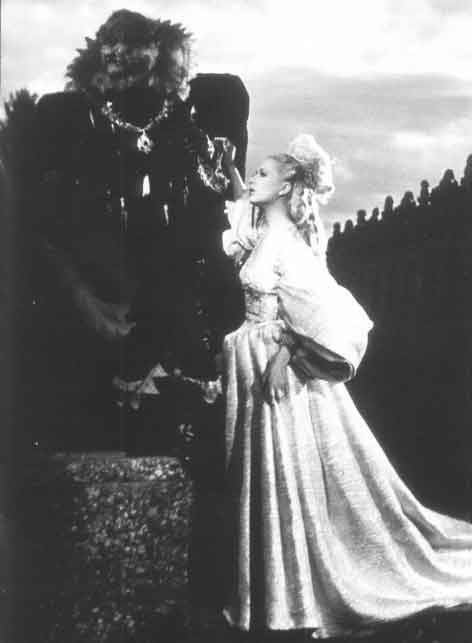
The "occurrence of the Stockholm syndrome is partly correlated with
the passage of time, and is greatly correlated with the amount of positive
contact between hostages and the hostage taker" (Wesselius 44). Cocteau
portrays Beauty's "three peaceful months" (Beaumont 138) at
the Beast's castle, primping at her dressing tale, napping, and taking
long walks through the castle garden. While some hostages may not immediately
attempt escape because of fear, time spent in captivity triggers and compounds
overwhelming feelings of dependence towards the hostage-taker (Wesselius
43) making it emotionally impossible for the hostage to leave.
But why does the Beast treat Beauty so kindly in the first place? "A
wicked fairy had doomed [the Beast] to keep his appearance until a beautiful
girl consented to marry [him]" (Beaumont 142). Like the robbers trapped
in the bank, the Beast's transgression traps him in his own fur, and motivates
his outward displays of kindness towards Beauty. He holds the keys to
his escape and relies on Beauty to succumb to his charms, causing a manifestation
of the Stockholm syndrome, with Beauty transferring feelings of love onto
the Beast, thereby releasing the Beast from his Ovidian prison and transforming
him into the prince. On the other hand, Bruno Bettelheim suggests Beauty's
affection for the Beast has nothing to do with the Stockholm syndrome.
Perhaps as Bettelheim posits, it is only the natural blossoming of Beauty's
sexuality-and this seems to be the way Jean Cocteau envisions the story.
Bettelheim
suggests that Beauty experiences "normal development, [when] sexual
longings no longer seem beastly-to the contrary, they are experienced
as beautiful" (Enchantment 308). Beauty must change her view of sex
as "disgusting" to "beautiful" by transferring the
Oedipal love for her father to the "more suitable" Beast (Bettelheim
Enchantment 303), or in Freudian terms, "the marriage of Beauty
and the Beast is the humanization and socialization of the id by the superego"
(Bettelheim Enchantment 304). Sigmund Freud describes human sexuality
in terms of Schiller's "'hunger and love are what move the world.'
Hunger could be taken to represent the instincts which aim at preserving
the individual; while love strives after objects, and its chief function,
favored in every way by nature, is the preservation of the species"
(Civilization 117). The idea that life is nothing but one's eternal
striving for sexual preservation, whether natural or a consequence of
neurosis, bothers intellectuals and analysts alike.
Beauty's rejection of the Beast takes on a life of its own. Every night
the Beast asks,"'Beauty, will you be my wife?'" (Beaumont 138).
And every night Beauty replies, "'No, Beast'" (Beaumont 138).
Just as Geoffrey Green describes in Freud and Nabokov, Nabokov's
"aversion to Freud becomes a thing Nabokovian, a part of the self
that is not the self" (77) and Beauty's continual rejection of the
Beast sets the same sort of tension in motion. Jack Zipes also reflects
disdain for the psychoanalytical when remarking, "numerous critics
and shamans have mystified and misinterpreted the fairy tale because of
their spiritual quest for universal archetypes or their need to save the
world through therapy" (Introduction xi). Dr. Dwayne Fuselier
makes a similar observation when commenting that the Stockholm syndrome,
"has been overemphasized, overanalyzed, overpsychologized, and overpublicized"
(22), believing the majority of captives rarely "sympathize"
or fall in love with their captors (22). But Beauty does not pick Beast
out of the available gene pool. She is his captive and she does fall in
love with him.
While Cocteau's film does not consciously present Beauty as a victim of
the Stockholm syndrome, it nevertheless emphasizes the Beast's inner goodness,
which somehow qualifies him as an acceptable mate for Beauty. In one five
minute segment of film, Beauty goes from swooning at her first glimpse
of the Beast to succumbing to the Beast's gentle prison because she can
tell he is, "doing everything possible to help [her] forget [his]
ugliness" (Cocteau 38:45). Beauty's ultimate kiss unwittingly rescues/transforms
the Beast obliterating his former transgression, while moving Beauty from
captive to jailor/liberator. But Beauty's authority is cut short by the
sudden appearance of the traditional handsome prince. To escape his prison,
the threatening, tooth-baring Beast suppresses his frustrations, in order
to become the virtuous Beast with whom Beauty falls in love. It is the
Beast's acts of kindness towards Beauty that causes her to manifest feelings
of love, or the Stockholm syndrome.
La Belle et la Bête maintains the moral conventions of female
self-sacrifice, while the camera reflects the Beast's personality wholly
onto the screen. The Beast's good and gentle inner qualities struggle
with his animal cunning in order to nurture Beauty's affections. Rather
than explode in anger, the Beast runs away from Beauty when she tells
him of her lover. When Beast's predatory nature is piqued by the appearance
of easy prey, he takes Beauty back to the castle before baring his claws,
and hunting down dinner.
Once Beauty arrives at the Beast's castle, Cocteau's audience watches
the Beast watch Beauty. The film cultivates the Beast's gaze, which sometimes
creates a feeling of menace by depicting a predatory man/beast whose animal
reflexes could snap at any moment. The feeling of watching extends to
the Beast's castle, with human-faced caryatids on the fireplace watching
Beauty's every move, hand-chandeliers pointing her along hallways, and
human-figured candelabras smiling affectionately over her. Cocteau's concentration
on the Beast's watching objectifies Beauty, and is elucidated by Cocteau's
observation that "the dresses come alive" (Diary 85), not the
actress in them. Beauty is a dress-up doll wandering through the castle
or its gardens, eating under the gaze of her captor, or sitting in her
room reading, daydreaming, and looking at herself in the mirror, a voyeuristic
view into a woman's boudoir.
Teresa
de Lauretis suggests films create visual texts. "The representation
of woman as spectacle-body to be looked at, place of sexuality, and object
of desire- . . . finds in narrative cinema its most complex expression
and widest circulation" (4). While the voyeurism of La Belle et
la Bête seems a function of looking, or rather, male gazing,
with the audience watching the Beast watch Beauty, it is contrary to the
oppressive male gaze. The Beast's staring functions to reveal his sensitive
inner nature and therefore dissipates the feeling of menace, while causing
Beauty to manifest neurosis, consequently directing affection his way.
Cocteau's vision of watching, proves that "love develops in the context
of seeing" (Hearne 181). Beauty has to observe the Beast's good behavior
over an extended period of time before falling in love with him. Watching
in Cocteau's film acts as a catalyst, shifting Beauty's revulsion, first
to sympathy, and then to love.
Loving to Survive proposes a "societal Stockholm syndrome"
to explain "women's femininity, love of men, and heterosexuality"
(Graham xvii). The authors theorize that, "like hostages who work
to placate their captors lest those captors kill them, women work to please
men, and from this springs women's femininity . . . Like hostages who
bond to their captors, women bond to men in an effort to survive"
(Graham xiv). A recent study "found female victims of domestic violence
often identified with [the] passive, female role models they had encountered
in fairy tales as children and believed that if their love was strong
enough they could change their partner's behavior" (Darker-Smith
1). Beauty and the Beast rang true with these women, and "may
be the reason why women remain locked in domestic abuse situations, feeling
powerless to leave" (Darker-Smith 2). Perhaps the women of the French
salon wrote Beauty and the Beast as an archetype for the Stockholm
syndrome they experienced in their own domestic spaces and relationships,
but could not identify.
Whether one views Beauty and the Beast as a subversive proto-feminist
tract denouncing the ills of a misogynistic patriarchy penned by the women
of the French salon, or as a treatise on morals designed to educate children,
or as a guide to female sexual maturity, Beauty's captivity within an
enchanted domestic space presents a troubling picture of feminine neurosis.
In a previous age, it could be said that the arranged marriage led to
a self-fulfilling prophecy of the Stockholm syndrome, and the women of
the French salon encoded this psychological neurosis into Beauty and
the Beast. Others suggest Beauty and the Beast helps girls
overcome their natural aversion to the sex act by transferring oedipal
feelings for their fathers onto appropriate male spouses. The ethereal
La Belle et La Bête presents a Beast whose watching facilitates
love, and a Beauty who succumbs to neurosis. Perhaps, Beauty's manifestation
of the Stockholm syndrome is love's catalyst.
Works Cited
Beaumont, Madame LePrince de. "Beauty and the Beast." 1756. Jean Cocteau. Beauty and the Beast: Diary of a Film. 1950. Trans. Ronald Duncan. New York: Dover, 1972.
Bettelheim, Bruno. The Uses of Enchantment. The Meaning and Importance of Fairy Tales. New York: Knopf, 1976.
Cocteau, Jean dir. La Belle et la Bęte. Perf. Jean Marais and Josette Day. Comité Cocteau, 1946. DVD. Criterion, 2003.
---. Beauty and the Beast: Diary of a Film. 1950. Trans. Ronald Duncan. New York: Dover, 1972.
Darker-Smith, Susan. "Fairy Tale Princes Turn into Beasts." Interview. Women's Feature Service. 13 June2005. Article. 16 Sept. 2005. <http://bob.csueastbay.edu>.
Freud,Sigmund. "Civilization and Its Discontents." The Standard Edition of the Complete Psychological Works of Sigmund Freud. Trans. and Ed. by James Strachey. Vol. 21. (1927-1931). London: Hogarth Press, 1961. 59-148.
Fuselier, G. Dwayne Ph.D. "Placing the Stockholm Syndrome in Perspective." FBI Law Enforcement Bulletin. July 1999. 22-25.
Giebels, Ellen, Sigrid Noelanders, and Geert Vervaeke. "The Hostage Experience: Implications for Negotiation Strategies." Clinical Psychology and Psychotherapy 12 (2005): 241-53.
Graham, Dee L. R., Edna I. Rawlings, and Roberta K. Rigsby. Loving to survive: Sexual terror, men's violence, and women's lives. New York: New York UP, 1994.
Green, Geoffrey. Freud and Nabokov. Lincoln: U of Nebraska P, 1988.
Hearne, Betsy. Beauty and the Beast. Visions and Revisions of an Old Tale. Chicago, U of Chicago P, 1989.
Lauretis, Teresa de. Alice Doesn't: Feminism, Semiotics, Cinema. Bloomington: Indiana UP, 1984.
Peel, Ellen. "'The Worst Wolves are Hairy on the Inside' Metaphor in Angela Carter's 'The Company of Wolves.'" Faculty Conference, English Dept. San Francisco State University. 23 Aug. 2005.
Ross, Deborah. "Escape from Wonderland: Disney and the Female Imagination." Marvels and Tales 18.1 (2004): 53-66.
Wesselius, Cassie L. M.D., James V. DeSarno. "The Anatomy of a Hostage Situation." Behavioral Sciences and the Law 1.2 (1983): 33-45.
Zipes, Jack. "Introduction." Spells of Enchantment. New York: Viking, 1991.
---. "Origins of the Fairy Tale for Children." Children and Their Books. A Celebration of Iona and Peter Opie. Eds. Gillian Avery and Julia Briggs. Oxford: Clarendon, 1989. 119-34.
---. When Dreams Came True: Classical Fairy Tales and Their Tradition. New York: Routledge, 1999.
All pictures from Diary of a Film by Jean Cocteau, Dover Publications, 1972.

